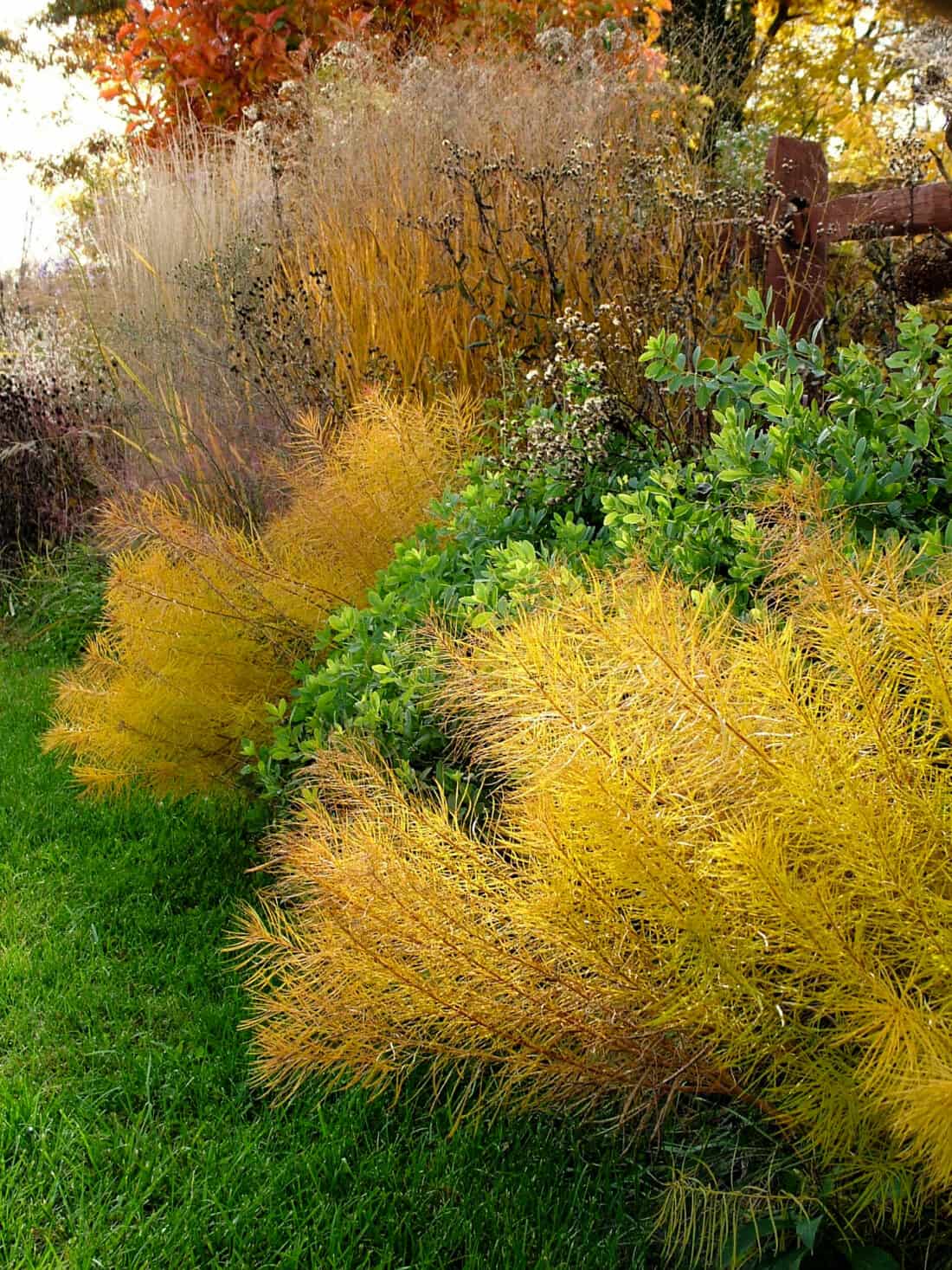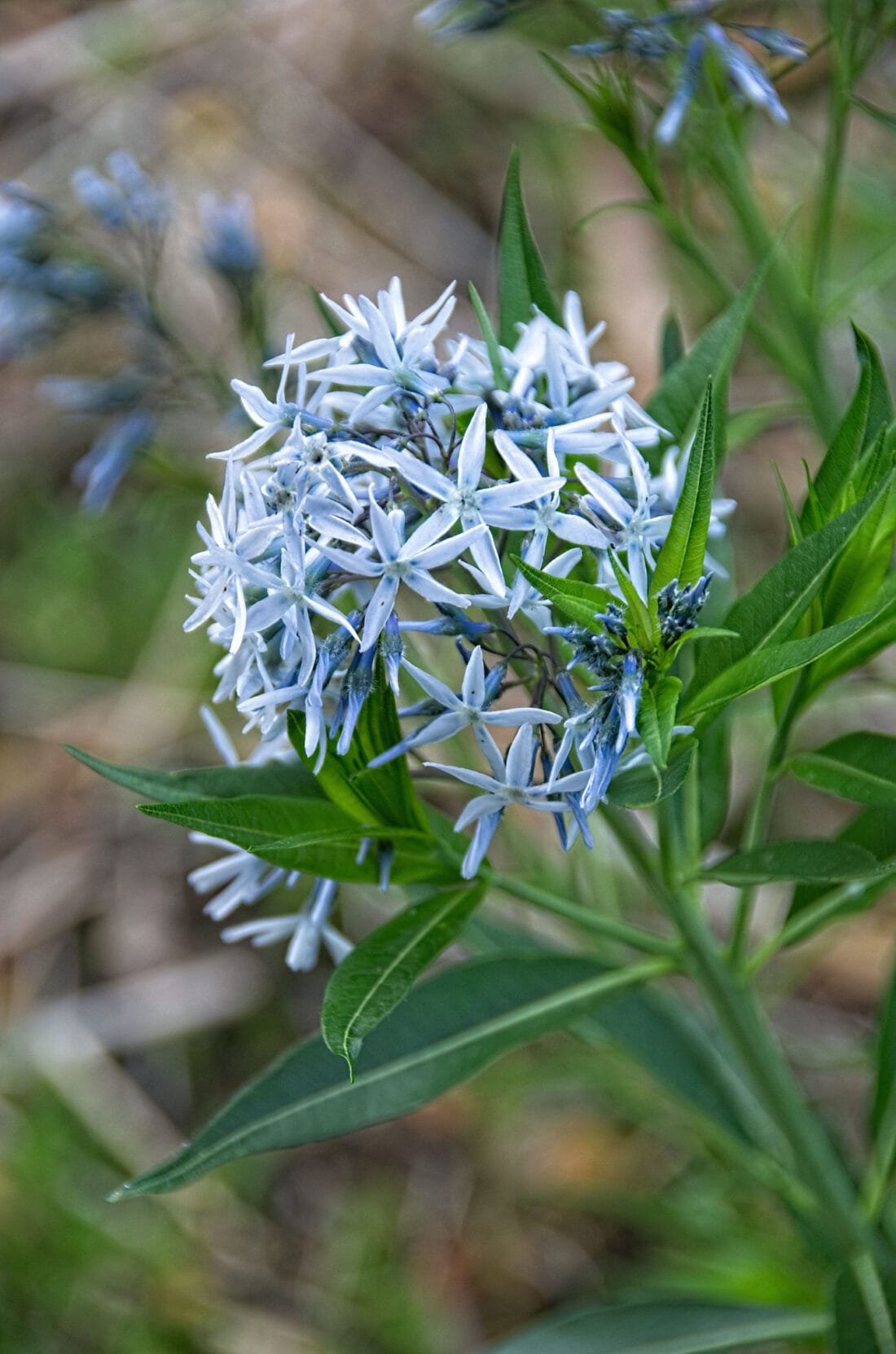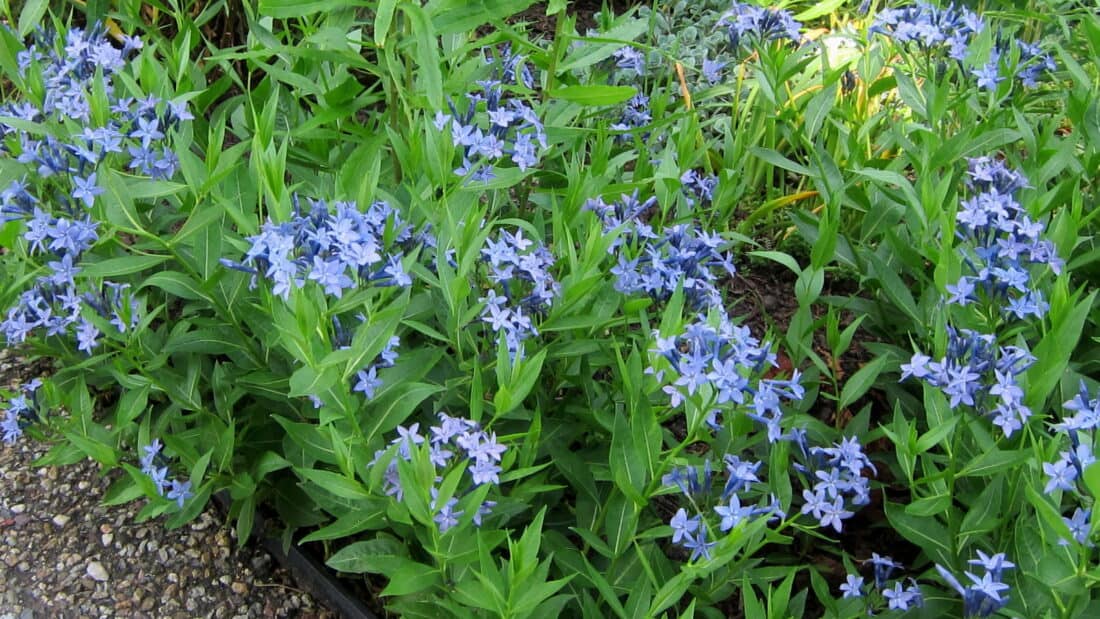I’ve been flirting with Amsonia for years. I can’t remember where we were the first time it caught my eye. It might have been a moment in a book or a magazine, but those ethereal mounds of yellow needle-like leaves with a texture like no other were definitely giving me the ‘come hither’ look. I didn’t catch its name at the time, but I remembered the face.
I didn’t know it, but a few years later, Amsonia caught my eye again when my kids were in elementary school. The local garden club made over the school’s front beds where parents drop off. Suddenly, there were a handful of plants with icy blue star eyes winking at me. Pale blue eyes are always enchanting. It ultimately took a few more years to realize that the frothy ferny yellow fall mounds were the same plant as the one with the light blue star-like flowers in the late spring.

I have a memory of some garden speaker somewhere noting how hard Amsonia can be to establish. He said that if you want a plant that looks like the picture below – you have to be very, very patient. The tone was ominous, and it put me off the plant for many more years.
With decades of garden-making under my belt, I often wonder why gardeners do this sort of thing. Put people off plants – especially native plants. A few years in a garden is nothing – most plants take that amount of time to really come into their own. I realize now that the lament about the plant was probably more about him than the plant.
Adding Amsonia to the Garden
I am finally adding Amsonia to my garden. I live in New England, and while there are many varieties of eastern bluestar, there are none that are truly native to my region. Most all Amsonia are native to the south and central United States. Adding them will be an interesting experiment.
Here are a few things I am considering as I choose which variety will work best in my garden.
My first consideration is design – I want to plant something that gives me that unique fern-like fall texture.

Amsonia hubrictii – Arkansas bluestar or Threadleaf Bluestar
Amsonia hubrichtii, also known as Hubricht’s bluestar and Arkansas bluestar, or thread-leaf bluestar, is hardy in my zone (it lives in zones 5-9). It is native to Arkansas and mountainous areas in the Southeastern US. – having been discovered there by its namesake, Leslie Hubrict, in 1942. These plants are, for the most part, semi-woody perennials with a clumping growth habit and small, star-shaped flowers.
It has an abundance of long, thread-like leaves that turn a stunning yellow color in autumn. It is very tolerant of hot and cold, as well as a variety of soil types.
Amsonia Hubrictii – Threadleaf Bluestar is also the Perennial Plant Association’s ‘Plant of the Year’ for 2011 (so it should be relatively easy to find).
This may be my ultimate choice because I really love the long needle-like leaves, and they are most pronounced with this variety. I do, however, want to make sure there aren’t better options, so these are the other varieties I am considering:
Amsonia tabernaemontana (Eastern Bluestar)
Amsonia tabernaemontana – Compared to A. Hubrictii, this variety of blue dogbane (another common name for Amsonia in general) has a more substantial look due to its wider leaves. Its common name is willow amsonia because of its likeness to leaf shape and size. It is also known as woodland bluestar. A. tabernaemontana is a native herbaceous perennial with a wider native range – it can be found across most of the eastern US, as far north as New Jersey. It has a neater appearance, and it is a strong second-choice plant that I would also consider adding to my garden.
One of these two varieties will ultimately make its way into my garden in 2024, replacing a couple of overgrown miscanthus grasses and filling in a few areas that could use a more dense layer of planting and interest.

Other options I researched that you might find interesting for your own garden:
Amsonia “Blue Ice” – or just Blue Ice – A short little plant with unclear origins. It is likely a hybrid of A. tabernaemontana and and an undetermined other parent that is probably native to North America and has stunning blue to purple flowers. Too short for my garden goals at half the size of other Amsonia (only 15-18 inches)
Amsonia peeblesii – Peebles’ bluestar is native to Arizona. It is a rare variety of Amsonia that is extremely drought tolerant and not the best choice for my garden.
Amsonia illustris – Native to the southeastern U.S., the Louisiana Bluestar, also known as Ozark Bluestar or swamp Bluestar, captivates with its distinctive leaves boasting fuzzy, white undersides and very shiny leaves (hence the name).

Amsonia ciliata – Fringed Bluestar – Also native to the southeastern U.S., this amsonia is also commonly called Texas Blue star or downy amsonia. It can only grow in very well-drained, sandy soil. It is known for its long, thread-like leaves covered in trailing hairs (similar to A. hubrictii in many ways except for the hairiness).
Amsonia orientalis – European bluestar is native to Greece and Turkey. It is harder to find in the US, and it is a shorter variety with round leaves.
All Amsonia have erect stems that emerge in early spring and tend to bloom in late spring to early summer. They want well-drained soil. Most a tolerant of full sun to partial shade. They are host plants to a wide variety of carpenter bees, various butterflies, and moths (especially hummingbird moths), and they draw in actual ruby-throated hummingbirds.
Native Bluestar FAQ
Most are 2-3 feet in all directions.
Most turn a bright yellow, but sometimes they have tinges of orange or red as well.
Even though they are cold hardy, others report that they benefit from the extra protection of mulch. I am inclined not to cut them back and let the leaf dieback be its only mulch.
Other posts you might be interested in:
a sea of yellow! beautiful.
Amsonias take at least 3 years to get established. My hubrichtii is a year old and it is flopping all over the ground like a toddler having a tantrum. But in a couple years it will fill out and get all frothy looking like the photos you show, and yes, they really do get bright yellow! They are very late to come up in the spring, and the pretty blue flowers are kind of brief, but it’s a really neat plant for leaf effect, structure, and certainly for that fall color!
THis plant is in my top ten list of plants for its all season interest. It has lovely blue star like flowers in the spring ( that do not need deadheading) then beautiful ferny foliage all summer long and then this incredible yellow smokebush like foliage in the fall. It is easy to grow and I love it
I just got some baby amsonias, from a gardening job- the clumps were seeding into the paths with enthusiasm, so I brought some of the wee unwanteds home. These happy clumps are on a rocky incline that is a )*$*! to water; they just sort of have bowls of enriched soil to grow in. The site gets sun about half the day. I fertilized them with time release mid summer, which is apparently what they have been getting in prior years. The leaves are *just* starting to change color. I was startled earlier in the year when they bloomed- they all went off at once, in a most lovely, icy blue.
I grew this at The New York Botanical Garden, and later in my garden in Atlanta. It is a fantastic perennial in either location. It will take at least 2 years to establish from a 1g pot size. You’ll wonder what’s so great the first year as it sprawls around near the ground. Wait for it though! It has very sweet pale blue flowers in early spring and has disease and pest resistant billowy foliage all summer before turning that amazing gold in the fall. Looks great in mass. Mine are planted only 1-1.5′ apart so I could get them to fill in faster. They aren’t suffering at all for close spacing. They each get about 3′ wide. They are very drought tolerant as well. I have them baking in a full sun, southern exposure, hot Atlanta bank in amended soil. They love it. In NY it was in afternoon sun and well irrigated. Very happy there too. Looks great with Sedum ‘Herbstfroede’ / Autumn Joy, Aster ‘October Skies’, Hibiscus ‘Kopper King’, Chrysanthemum ‘Thanksgiving’ and Nepeta ‘Walker’s Low’.